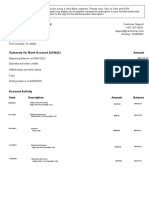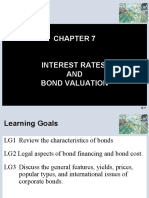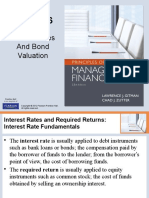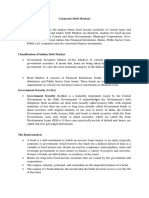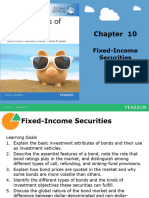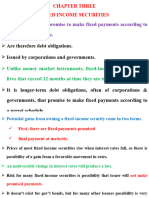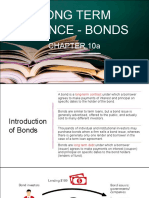0 ratings0% found this document useful (0 votes)
5 viewsFoundations of Finance: Tenth Edition, Global Edition
Foundations of Finance: Tenth Edition, Global Edition
Uploaded by
Semih AYBASTICopyright:
© All Rights Reserved
Available Formats
Download as PDF, TXT or read online from Scribd
Foundations of Finance: Tenth Edition, Global Edition
Foundations of Finance: Tenth Edition, Global Edition
Uploaded by
Semih AYBASTI0 ratings0% found this document useful (0 votes)
5 views58 pagesOriginal Title
7
Copyright
© © All Rights Reserved
Available Formats
PDF, TXT or read online from Scribd
Share this document
Did you find this document useful?
Is this content inappropriate?
Copyright:
© All Rights Reserved
Available Formats
Download as PDF, TXT or read online from Scribd
Download as pdf or txt
0 ratings0% found this document useful (0 votes)
5 views58 pagesFoundations of Finance: Tenth Edition, Global Edition
Foundations of Finance: Tenth Edition, Global Edition
Uploaded by
Semih AYBASTICopyright:
© All Rights Reserved
Available Formats
Download as PDF, TXT or read online from Scribd
Download as pdf or txt
You are on page 1of 58
Foundations of Finance
Tenth Edition, Global Edition
Chapter 7
The Valuation and
Characteristics of Bonds
Slide in this Presentation Contain Hyperlinks.
JAWS users should be able to get a list of links
by using INSERT+F7
Copyright © 2020 Pearson Education Ltd. All Rights Reserved
Learning Objectives
7.1 Distinguish between different kinds of bonds.
7.2 Explain the more popular features of bonds.
7.3 Define the term value as used for several different purposes.
7.4 Explain the factors that determine value.
7.5 Describe the basic process for valuing assets.
7.6 Estimate the value of a bond.
7.7 Compute a bond’s expected rate of return and its current
yield.
7.8 Explain three important relationships that exist in bond
valuation.
Copyright © 2020 Pearson Education Ltd. All Rights Reserved
Types of Bonds
Copyright © 2020 Pearson Education Ltd. All Rights Reserved
Bonds
• Meaning: A bond is a type of debt or long-term promissory
note, issued by a borrower, promising to its holder a
predetermined and fixed amount of interest per year and
repayment of principal at maturity.
• Bonds are issued by corporations, the U.S. government,
state governments, and local municipalities.
Copyright © 2020 Pearson Education Ltd. All Rights Reserved
Debentures
• Debentures are unsecured long-term debt.
• For an issuing firm, debentures provide the benefit of not
tying up property as collateral.
• For bondholders, debentures are more risky than secured
bonds and provide a higher yield than secured bonds.
Copyright © 2020 Pearson Education Ltd. All Rights Reserved
Subordinated Debentures
• There is a hierarchy of payout in case of insolvency.
• The claims of subordinated debentures are honored only
after the claims of secured debt and unsubordinated
debentures have been satisfied.
Copyright © 2020 Pearson Education Ltd. All Rights Reserved
Mortgage Bonds
• Mortgage bond is secured by a lien on real property.
• Typically, the value of the real property is greater than
that of the bonds issued, providing bondholders a margin
of safety.
Copyright © 2020 Pearson Education Ltd. All Rights Reserved
Eurobonds
• Securities (bonds) issued in a country different from the
one in whose currency the bond is denominated.
• For example, a bond issued by an American corporation in
Japan that pays interest and principal in dollars.
Copyright © 2020 Pearson Education Ltd. All Rights Reserved
Convertible Bonds
• Convertible bonds are debt securities that can be
converted into a firm’s stock at a prespecified price.
Copyright © 2020 Pearson Education Ltd. All Rights Reserved
Terminologies and Characteristics of
Bonds
Copyright © 2020 Pearson Education Ltd. All Rights Reserved
Claims on Assets and Income
• Seniority in claims
– In the case of insolvency, claims of debt, including
bonds, are generally honored before those of common
or preferred stock.
Copyright © 2020 Pearson Education Ltd. All Rights Reserved
Par Value
• Par value is the face value of the bond, returned to the
bondholder at maturity.
• In general, corporate bonds are issued at denominations
or par value of $1,000.
• Prices are represented as a percentage of face value.
Thus, a bond quoted at 104 can be bought at 104 percent
of its par value in the market. Bonds will return the par
value at maturity, regardless of the price paid at the time
of purchase.
Copyright © 2020 Pearson Education Ltd. All Rights Reserved
Coupon Interest Rate
• The percentage of the par value of the bond that will be
paid periodically in the form of interest.
• Example: A bond with a $1,000 par value and 5 percent
annual coupon rate will pay $50 annually (= 0.05×1,000)
or $25 (if interest is paid semiannually).
Copyright © 2020 Pearson Education Ltd. All Rights Reserved
Zero Coupon Bonds
• Zero coupon bonds have zero or very low coupon rate.
Instead of paying interest, the bonds are issued at a
substantial discount below the par or face value.
Copyright © 2020 Pearson Education Ltd. All Rights Reserved
Maturity
• Maturity of bond refers to the length of time until the bond
issuer returns the par value to the bondholder and
terminates or redeems the bond.
Copyright © 2020 Pearson Education Ltd. All Rights Reserved
Call Provision
• Call provision (if it exists on a bond) gives a corporation
the option to redeem the bonds before the maturity date.
For example, if the prevailing interest rate declines, the
firm may want to pay off the bonds early and reissue at a
more favorable interest rate.
• Issuer must pay the bondholders a premium.
• There is also a call protection period where the firm
cannot call the bond for a specified period of time.
Copyright © 2020 Pearson Education Ltd. All Rights Reserved
Indenture
• An indenture is the legal agreement between the firm
issuing the bond and the trustee who represents the
bondholders.
• It provides for specific terms of the loan agreement (such
as rights of bondholders and issuing firm).
• Many of the terms seek to protect the status of bonds from
being weakened by managerial actions or by other
security holders.
Copyright © 2020 Pearson Education Ltd. All Rights Reserved
Bond Ratings
• Bond ratings reflect the future risk potential of the bonds.
• Three prominent bond rating agencies are Standard &
Poor’s, Moody’s, and Fitch Investor Services.
• A lower bond rating indicates higher probability of default.
It also means that the rate of return demanded by the
capital markets will be higher on such bonds.
Copyright © 2020 Pearson Education Ltd. All Rights Reserved
Table 7.1 Standard & Poor’s
Corporate Bond Ratings
Source: Adapted from https://www.globalcreditportal.com, accessed May 20, 2015.
Copyright © 2020 Pearson Education Ltd. All Rights Reserved
Factors Having a Favorable Effect on
Bond Rating
• A greater reliance on equity as opposed to debt in
financing the firm
• Profitable operations
• Low variability in past earnings
• Large firm size
• Little use of subordinated debt
Copyright © 2020 Pearson Education Ltd. All Rights Reserved
Junk Bonds
• Junk bonds are high-risk bonds with ratings of BB or
below by Moody’s and Standard & Poor’s.
• Junk bonds are also referred to as high-yield bonds
because they pay a high interest rate, generally 3 percent
to 5 percent more than AAA-rated bonds.
Copyright © 2020 Pearson Education Ltd. All Rights Reserved
Defining Value
Copyright © 2020 Pearson Education Ltd. All Rights Reserved
Defining Value
• Book value: Value of an asset as shown on a firm’s
balance sheet.
• Liquidation value: The dollar sum that could be realized
if an asset were sold individually and not as part of a
going concern.
• Market value: The observed value for the asset in the
marketplace.
• Intrinsic or economic value: Also called fair value—
represents the present value of the asset’s expected
future cash flows.
Copyright © 2020 Pearson Education Ltd. All Rights Reserved
Value and Efficient Markets
• In an efficient market, the values of all securities at any
instant fully reflect all available public information.
• If the markets are efficient, the market value and the
intrinsic value will be the same.
• The field of behavioral finance studies the irrationality of
investors.
Copyright © 2020 Pearson Education Ltd. All Rights Reserved
What Determines Value?
Copyright © 2020 Pearson Education Ltd. All Rights Reserved
What Determines Value?
• Value of an asset = present value of its expected future
cash flows using the investor’s required rate of return as
the discount rate.
• Thus value is affected by three elements:
– Amount and timing of the asset’s expected future cash
flows
– Riskiness of the cash flows
– Investor’s required rate of return for undertaking the
investment
Copyright © 2020 Pearson Education Ltd. All Rights Reserved
Figure 7.1 Basic Factors Determining
an Asset’s Value
Copyright © 2020 Pearson Education Ltd. All Rights Reserved
Valuation: The Basic Process
Copyright © 2020 Pearson Education Ltd. All Rights Reserved
Bond Valuation (1 of 2)
• The value of a bond (V) is a combination of:
– C: Future expected cash flows in the form of interest
and repayment of principal
– n: The time to maturity of the loan
– r: The investor’s required rate of return
Copyright © 2020 Pearson Education Ltd. All Rights Reserved
Bond Valuation (2 of 2)
cash flow in year 1 cash flow in year 2
Asset value = +
(1 + required rate of return ) (1 + required rate of return )
1 2
cash flow in year n
+... +
(1 + required rate of return )
n
Or stated in symbols we have:
C1 C2 Cn
v= + + ... +
(1 + r ) (1 + r ) (1 + r )
1 2 n
Copyright © 2020 Pearson Education Ltd. All Rights Reserved
Valuing Bonds
Copyright © 2020 Pearson Education Ltd. All Rights Reserved
Figure 7.2 Data Requirements for
Bond Valuation
Copyright © 2020 Pearson Education Ltd. All Rights Reserved
Example on Bond Valuation
• Consider a bond issued by Toyota with a maturity date of
2022 and a stated coupon of 3.4 percent. In 2017, with 5
years left to maturity, investors owning the bonds are
requiring a 2.7 percent rate of return.
Copyright © 2020 Pearson Education Ltd. All Rights Reserved
Toyota Bond Example
• Step 1 (CF): Estimate amount and timing of the expected
future cash flows:
a. Annual interest payments
0.034 × $1,000 = $34 every year for five years
b. Face value to be received in 2022
$1,000
Copyright © 2020 Pearson Education Ltd. All Rights Reserved
Summary of Cash Flows (For One
Bond)
Time Bondholder Corporation
0 Price = ? Price = ?
1–5 $34 −$34
5 +1,000 −1,000
Copyright © 2020 Pearson Education Ltd. All Rights Reserved
Toyota Bond Example (1 of 3)
• Step 2 (r) Determine the investor’s required rate of return
by evaluating the riskiness of the bond’s future cash flows.
Remember: the investors required rate of return equals
the risk-free rate plus a risk premium. Here, the required
rate of return (r) is given as 2.7 percent.
Copyright © 2020 Pearson Education Ltd. All Rights Reserved
Toyota Bond Example (2 of 3)
• Step 3: Calculate the intrinsic value of the bond.
• Bond Value
– = PV (Interest, received every year)
– + PV (Par, received at maturity)
Copyright © 2020 Pearson Education Ltd. All Rights Reserved
Toyota Bond Example (3 of 3)
• Using calculator:
– Annual interest payments (PMT) = $34
– Par value (FV) = $1,000
– Years until maturity (N) = 5
– Required rate of return (I) = 2.7%
• Solve for PV = $1,032.33
Copyright © 2020 Pearson Education Ltd. All Rights Reserved
Bond Yields
Copyright © 2020 Pearson Education Ltd. All Rights Reserved
Bond Yields (1 of 2)
• Yield to Maturity (YTM) refers to the rate of return the
investor will earn if the bond is held to maturity. YTM is
also known as bondholder’s expected rate of return.
• YTM = Discount rate that equates the present value of the
future cash flows with the current market price of the bond
Copyright © 2020 Pearson Education Ltd. All Rights Reserved
Bond Yields (2 of 2)
To find YTM, we need to know:
a. current price
b. time left to maturity
c. par value, and
d. annual interest payment
Copyright © 2020 Pearson Education Ltd. All Rights Reserved
Computing YTM (1 of 2)
• What is the yield to maturity (YTM) on a 6 percent bond
that is currently trading for $1,100 and matures in 10
years?
• Current price = $1,100
Coupon = $60
Time = 10 years
Par value = $1,000
Copyright © 2020 Pearson Education Ltd. All Rights Reserved
Computing YTM (2 of 2)
Copyright © 2020 Pearson Education Ltd. All Rights Reserved
Current Yield
• Current yield is the ratio of the interest payment to the
bond’s current market price.
annual interest payment
Current yield =
current market price of the bond
• Example: The current yield on a $1,000 par value bond
with 4 percent coupon rate and market price of $920
0.04 × $1, 000 $40
Current yield = = = 0.0435 = 4.35%
$920 $920
Copyright © 2020 Pearson Education Ltd. All Rights Reserved
Bond Valuation: Three Important
Relationships
Copyright © 2020 Pearson Education Ltd. All Rights Reserved
Bond Valuation: Three Important
Relationships (1 of 2)
Relationship 1
• The value of a bond is inversely related to changes in the
investor’s present required rate of return (the current
interest rate).
• As interest rates increase (decrease), the value of the
bond decreases (increases).
Copyright © 2020 Pearson Education Ltd. All Rights Reserved
Bond Valuation: Three Important
Relationships (2 of 2)
Relationship 2
• The market value of a bond will be less than the par value
if the investor’s required rate of return is above the coupon
interest rate.
• Bond will be valued above par value if the investor’s
required rate of return is below the coupon interest rate.
Copyright © 2020 Pearson Education Ltd. All Rights Reserved
Discount Bonds
• The market value of a bond will be below the par when the
investor’s required rate is greater than the coupon interest
rate. These bonds are known as discount bonds.
Copyright © 2020 Pearson Education Ltd. All Rights Reserved
Premium Bonds
• The market value of a bond will be above the par or face
value when the investor’s required rate is lower than the
coupon interest rate. These bonds are known as premium
bonds.
• If investor’s required rate of return is equal to the coupon
interest rate, the bonds will trade at par.
Copyright © 2020 Pearson Education Ltd. All Rights Reserved
Figure 7.3 Value and Required Rates
for a 5-Year Bond at a 5 Percent
Coupon Rate
Copyright © 2020 Pearson Education Ltd. All Rights Reserved
Bond Valuation: Three Important
Relationships (3 of 3)
Relationship 3
• Long-term bonds have greater interest rate risk than do
short-term bonds.
• In other words, a change in interest rate will have
relatively greater impact on long-term bonds.
Copyright © 2020 Pearson Education Ltd. All Rights Reserved
Figure 7.4 The Market Values of a 5-
Year and a 10-Year Bond at Different
Required Rates of Return
Copyright © 2020 Pearson Education Ltd. All Rights Reserved
Main Risks for Bondholders
• Interest rate risk: if interest rates rise, the market value of
bonds will fall
• Default risk: this may mean no or partial payment on debt
as in bankruptcy cases
• Call risk: if bonds are called before maturity date; bonds
are generally called when interest rates decrease. Thus,
investors will have to reinvest the money received from
the corporation at a lower rate.
Copyright © 2020 Pearson Education Ltd. All Rights Reserved
Key Terms (1 of 4)
• Behavioral finance
• Bond
• Book value
• Callable bond (redeemable bond)
• Call protection period
• Convertible bond
• Coupon interest rate
• Current yield
Copyright © 2020 Pearson Education Ltd. All Rights Reserved
Key Terms (2 of 4)
• Debenture
• Discount bond
• Efficient market
• Eurobond
• Expected rate of return
• Fixed-rate bond
• Fair value
• High-yield bond
Copyright © 2020 Pearson Education Ltd. All Rights Reserved
Key Terms (3 of 4)
• Indenture
• Interest rate risk
• Intrinsic, or economic (fair) value
• Junk bond (high-yield bond)
• Liquidation value
• Market value
• Maturity
• Mortgage bond
Copyright © 2020 Pearson Education Ltd. All Rights Reserved
Key Terms (4 of 4)
• Par value
• Premium bond
• Subordinated debentures
• Yield to maturity
• Zero coupon bond
Copyright © 2020 Pearson Education Ltd. All Rights Reserved
Copyright
This work is protected by United States copyright laws and is
provided solely for the use of instructors in teaching their
courses and assessing student learning. Dissemination or sale of
any part of this work (including on the World Wide Web) will
destroy the integrity of the work and is not permitted. The work
and materials from it should never be made available to students
except by instructors using the accompanying text in their
classes. All recipients of this work are expected to abide by these
restrictions and to honor the intended pedagogical purposes and
the needs of other instructors who rely on these materials.
Copyright © 2020 Pearson Education Ltd. All Rights Reserved
You might also like
- Varo Bank Account Statement: AmountDocument2 pagesVaro Bank Account Statement: Amountmichael100% (1)
- DEF CON 21-RFID HackingDocument50 pagesDEF CON 21-RFID HackingSemih AYBASTI100% (1)
- USDT BTC Swap - 18500 BTC - 8% (Gross) - 4% (Net) - 10 Jan 2023 V4-ADocument4 pagesUSDT BTC Swap - 18500 BTC - 8% (Gross) - 4% (Net) - 10 Jan 2023 V4-AASAP CHAKINo ratings yet
- ACBP5122wA1 PDFDocument9 pagesACBP5122wA1 PDFAmmarah Ramnarain0% (1)
- Chapter 5 Bonds and StocksDocument61 pagesChapter 5 Bonds and StocksJulie Mae Caling MalitNo ratings yet
- The Culture of SuccessDocument10 pagesThe Culture of Successanon_454235256100% (1)
- LN07 Keown33019306 08 LN07 GEDocument56 pagesLN07 Keown33019306 08 LN07 GEEnny HaryantiNo ratings yet
- Fin254 Chapter 6Document18 pagesFin254 Chapter 6Wasif KhanNo ratings yet
- Chapter 6 and 7 Moyer Financial AdministrationDocument50 pagesChapter 6 and 7 Moyer Financial AdministrationScribdTranslationsNo ratings yet
- Bond ValuationDocument43 pagesBond ValuationAMER KHALIQUENo ratings yet
- Interest Rates and Bond Valuation: All Rights ReservedDocument30 pagesInterest Rates and Bond Valuation: All Rights ReservedAbdur Rahaman Kashemi 1520647031No ratings yet
- Lecture 6 - Interest Rates and Bond ValuationDocument56 pagesLecture 6 - Interest Rates and Bond Valuationabubaker janiNo ratings yet
- Financing Source - Debt ValuationDocument56 pagesFinancing Source - Debt ValuationTacitus KilgoreNo ratings yet
- Chapter 7 - 18may 2022Document51 pagesChapter 7 - 18may 2022Hazlina HusseinNo ratings yet
- Bondvaluation FinalforstudentDocument56 pagesBondvaluation FinalforstudentShekhar TripathiNo ratings yet
- Topic 2 - Basics of Valuation and Bond ValuationDocument43 pagesTopic 2 - Basics of Valuation and Bond ValuationSin Yee HohNo ratings yet
- Module - Iii Long Term Debt Securities: Ms. Alfia ThahaDocument50 pagesModule - Iii Long Term Debt Securities: Ms. Alfia ThahaDavid JohnNo ratings yet
- SPOELEC FinalsDocument6 pagesSPOELEC Finalslor ًNo ratings yet
- Bonds: Here Are Some Benefits They Can ProvideDocument7 pagesBonds: Here Are Some Benefits They Can ProvidefaqehaNo ratings yet
- Fixed Income Securities - 8Document24 pagesFixed Income Securities - 8SHRIRAJ LIGADENo ratings yet
- Chapter 06 GitmanDocument38 pagesChapter 06 GitmanLBL_LowkeeNo ratings yet
- Inv. Portfolio MGT Midterm LecturesDocument40 pagesInv. Portfolio MGT Midterm Lecturesocampojohnoliver1901182No ratings yet
- Chapter IV Suplimentary 2Document25 pagesChapter IV Suplimentary 2henokal99No ratings yet
- Lecture-8-10 Bond ValutionDocument44 pagesLecture-8-10 Bond Valutionfurqankhalid1218No ratings yet
- Chapter 5Document24 pagesChapter 5ericlee631615No ratings yet
- Managerial Finance chp6Document14 pagesManagerial Finance chp6Linda Mohammad FarajNo ratings yet
- FM Ch4 Bond & Stock EvDocument40 pagesFM Ch4 Bond & Stock Evtemesgen yohannesNo ratings yet
- Reading 39 - Fixed Income Securities - Defining ElementsDocument36 pagesReading 39 - Fixed Income Securities - Defining ElementsAllen AravindanNo ratings yet
- Bonds CH08Document16 pagesBonds CH08Hendrickson Cruz SaludNo ratings yet
- Fixed Income Securities: July 2011Document16 pagesFixed Income Securities: July 2011Vivek Sharma100% (2)
- Basic of BondsDocument18 pagesBasic of Bondse.nicolasNo ratings yet
- Bond Price and YieldDocument13 pagesBond Price and YieldHarsh RajNo ratings yet
- Bond and Its ValuationDocument37 pagesBond and Its ValuationSummit MirzaNo ratings yet
- Week 7 - Debt Financing Part 1 - Sem 2 2022-23Document42 pagesWeek 7 - Debt Financing Part 1 - Sem 2 2022-23AnselmNo ratings yet
- Corporate Debt Markets The Debt MarketDocument7 pagesCorporate Debt Markets The Debt MarketYashwanth Naik SNo ratings yet
- Topic 2 - Bond Valuation-A132Document58 pagesTopic 2 - Bond Valuation-A132Baby KhorNo ratings yet
- Lecture 4 - Bond MarketsDocument50 pagesLecture 4 - Bond MarketsTonie NascentNo ratings yet
- Module 7 - Bond ValuationDocument37 pagesModule 7 - Bond ValuationMethlyNo ratings yet
- LN01 Smart3075419 13 FI C10 EditedDocument58 pagesLN01 Smart3075419 13 FI C10 EditedNgọcNo ratings yet
- Debt ValuationDocument30 pagesDebt ValuationSiddharth BirjeNo ratings yet
- Capital Markets - BondsDocument26 pagesCapital Markets - Bonds2023017 AKSHAY RNo ratings yet
- CH-3 TVMDocument82 pagesCH-3 TVMyonastade81No ratings yet
- Portfolio Management: Dr. Himanshu Joshi FORE School of Management New DelhiDocument25 pagesPortfolio Management: Dr. Himanshu Joshi FORE School of Management New Delhiashishbansal85No ratings yet
- Chapter-6-RT - (Risk & Term Structure of Interest Rate) - W-18-UpdatedDocument55 pagesChapter-6-RT - (Risk & Term Structure of Interest Rate) - W-18-Updatedcanuck99No ratings yet
- ch09 PPT Kidwell 4e Bond-Markets-And-ValuationDocument35 pagesch09 PPT Kidwell 4e Bond-Markets-And-ValuationAlexa Daphne M. EquisabalNo ratings yet
- Corporate BondDocument14 pagesCorporate BondRavi WadherNo ratings yet
- Are Securities That Promise To Make Fixed Payments According ToDocument26 pagesAre Securities That Promise To Make Fixed Payments According Toaddisyawkal18No ratings yet
- BFC5926 Seminar 5 - Long-Term Debt MarketsDocument58 pagesBFC5926 Seminar 5 - Long-Term Debt MarketsMengdi ZhangNo ratings yet
- Corporate Bond/ Debentures (Long Term) MarketDocument92 pagesCorporate Bond/ Debentures (Long Term) Marketum24019No ratings yet
- Topic 4 & 5 - Bond Yields and Prices (STU)Document67 pagesTopic 4 & 5 - Bond Yields and Prices (STU)Thanh XuânNo ratings yet
- LM01 Fixed-Income Instrument Features IFT NotesDocument8 pagesLM01 Fixed-Income Instrument Features IFT NotesClaptrapjackNo ratings yet
- Module 5Document5 pagesModule 5ANSLEY CATE C. GUEVARRANo ratings yet
- Chapter - 10 - Fixed Income Securities - GitmanDocument39 pagesChapter - 10 - Fixed Income Securities - GitmanJessica Charoline PangkeyNo ratings yet
- 01 FM&I Chap 5 Bond MKTDocument57 pages01 FM&I Chap 5 Bond MKTDieuu LinhhNo ratings yet
- Chapter 7a - Bonds ValuationDocument22 pagesChapter 7a - Bonds ValuationAian Cortez100% (1)
- FINC639.15Spring2017 (Pepperdine University)Document21 pagesFINC639.15Spring2017 (Pepperdine University)RickzfunNo ratings yet
- CHP 6Document49 pagesCHP 6Khaled A. M. El-sherifNo ratings yet
- FM - Chapter 3Document6 pagesFM - Chapter 3sajal30No ratings yet
- Bond - Equity ValuationsDocument21 pagesBond - Equity ValuationsPraveen Kumar SinhaNo ratings yet
- The Valuation and Characteristics of BondsDocument56 pagesThe Valuation and Characteristics of BondsErlangga100% (1)
- Bonds and FI Training NovDocument35 pagesBonds and FI Training Nov吴孝伟No ratings yet
- Chapter 10a Long Term Finance - BondsDocument33 pagesChapter 10a Long Term Finance - BondsIvy CheekNo ratings yet
- Chapter 8 Fixed Income SecuritiesDocument35 pagesChapter 8 Fixed Income SecuritiesCezarene Fernando100% (1)
- Section 3: SwapsDocument32 pagesSection 3: Swapsswesam123No ratings yet
- Fixed Income Securities: A Beginner's Guide to Understand, Invest and Evaluate Fixed Income Securities: Investment series, #2From EverandFixed Income Securities: A Beginner's Guide to Understand, Invest and Evaluate Fixed Income Securities: Investment series, #2No ratings yet
- Disaster Transport JR Pedal Kit InstructionsDocument14 pagesDisaster Transport JR Pedal Kit InstructionsSemih AYBASTINo ratings yet
- Foundations of Finance: Tenth Edition, Global EditionDocument57 pagesFoundations of Finance: Tenth Edition, Global EditionSemih AYBASTINo ratings yet
- Foundations of Finance: Tenth Edition, Global EditionDocument68 pagesFoundations of Finance: Tenth Edition, Global EditionSemih AYBASTINo ratings yet
- Guitar TabDocument1 pageGuitar TabSemih AYBASTINo ratings yet
- CH 7-8Document47 pagesCH 7-8TesterzzzNo ratings yet
- Tax Audit ChecklistDocument1 pageTax Audit ChecklistSwapnil S DeshpandeNo ratings yet
- Treasury Bills: Getting The Price From The Interest RateDocument2 pagesTreasury Bills: Getting The Price From The Interest RateAnav AggarwalNo ratings yet
- Winter Exam-2019 Pakistan Institute of Public Finance AccountantsDocument3 pagesWinter Exam-2019 Pakistan Institute of Public Finance AccountantsJawadNo ratings yet
- Governmental Fund Accounting CycleDocument3 pagesGovernmental Fund Accounting CycleMannyNo ratings yet
- E-Way Bill SystemDocument1 pageE-Way Bill SystemAnil SainiNo ratings yet
- Income Tax Department 194IDocument1 pageIncome Tax Department 194ICA Vinit SharmaNo ratings yet
- Dissertation For Mba Finance StudentsDocument7 pagesDissertation For Mba Finance StudentsBuyingPapersCanada100% (1)
- Accounting For Decision Making: Unit-Iii Accounting Principles & ConventionsDocument24 pagesAccounting For Decision Making: Unit-Iii Accounting Principles & ConventionsVishal ChandakNo ratings yet
- Assignment #1 March 2020 Semester: Advanced Financial AccountingDocument11 pagesAssignment #1 March 2020 Semester: Advanced Financial AccountingPrabavathi KarunanithiNo ratings yet
- 2022-S SUP 3043 - 1 Assignment 1 - StudentDocument3 pages2022-S SUP 3043 - 1 Assignment 1 - StudentShravanNo ratings yet
- 7 - Long-Term Construction ContractsDocument6 pages7 - Long-Term Construction ContractsDarlene Faye Cabral RosalesNo ratings yet
- Report On Waghbakri by VishalDocument37 pagesReport On Waghbakri by VishalVishal Shah100% (4)
- AIMA Journal - Edition 117Document88 pagesAIMA Journal - Edition 117eliNo ratings yet
- Economics For CM 6 (Profit Concept)Document41 pagesEconomics For CM 6 (Profit Concept)nishant khadkaNo ratings yet
- Formation of A CompanyDocument22 pagesFormation of A CompanyHimura SanzouNo ratings yet
- Bfs Property Listing For Posting As of December 15 2016 Public Version CompressedDocument20 pagesBfs Property Listing For Posting As of December 15 2016 Public Version Compressedxandie_sacroNo ratings yet
- A222 BWBB3193 Topic 05 - Fin Ratio Part 2Document41 pagesA222 BWBB3193 Topic 05 - Fin Ratio Part 2NurFazalina AkbarNo ratings yet
- What Wicksell Hayek Fischer Knew and Mainstream Forgot Adair Turner Stockholm School of Economics September 12Document38 pagesWhat Wicksell Hayek Fischer Knew and Mainstream Forgot Adair Turner Stockholm School of Economics September 12IoproprioioNo ratings yet
- 2018 ADB Annual ReportDocument116 pages2018 ADB Annual ReportFuaad DodooNo ratings yet
- Current & Saving Account StatementDocument19 pagesCurrent & Saving Account StatementNARUTONo ratings yet
- Part 3 - Buy Vs Sell Order TypesDocument16 pagesPart 3 - Buy Vs Sell Order TypesAyi BasseyNo ratings yet
- Valivuokrasopimuspohja Eng Uusi 1 1 - SubleaseDocument2 pagesValivuokrasopimuspohja Eng Uusi 1 1 - Subleaseatikurahman.fiNo ratings yet
- Farmer Producer OrganisationsDocument158 pagesFarmer Producer OrganisationsAbhinav tiwariNo ratings yet
- HSBC Amfi Mock Test-1Document10 pagesHSBC Amfi Mock Test-1Ankit Sharma100% (1)
- Up To 2020-02-18 - HSBC Business Direct Portfolio Summary 02 - StatementDocument3 pagesUp To 2020-02-18 - HSBC Business Direct Portfolio Summary 02 - StatementLevi dos SantosNo ratings yet
